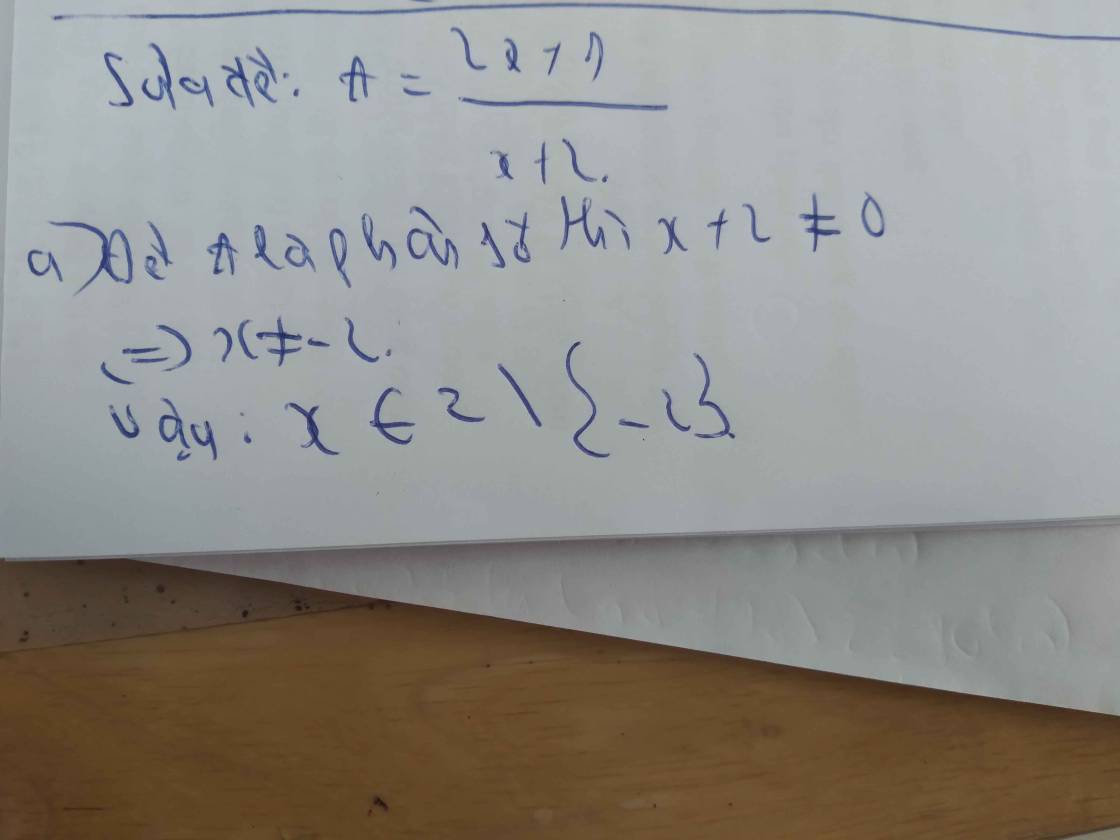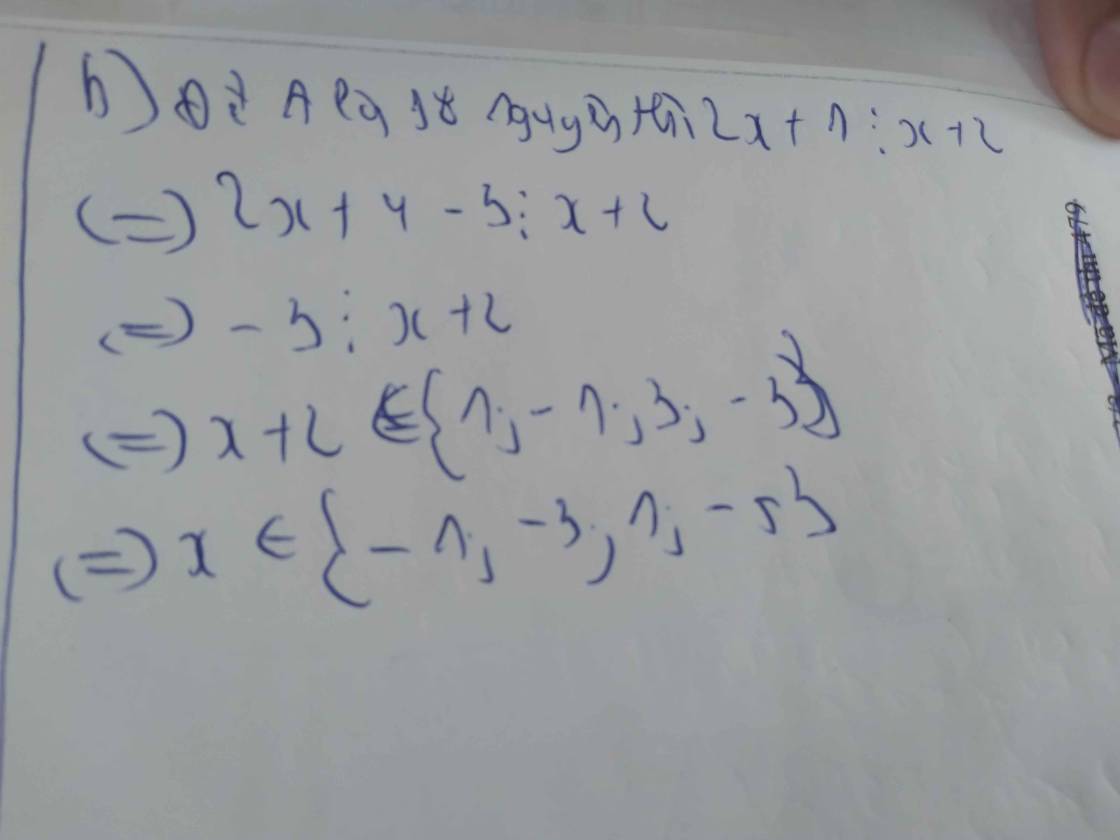cho biểu thức A = 2 x 1 / x + 2
Tìm các số nguyên X để biểu thức A là phân số
Tìm các số nguyên X để biểu thức A có giá trị là một số nguyên
Hãy nhập câu hỏi của bạn vào đây, nếu là tài khoản VIP, bạn sẽ được ưu tiên trả lời.




A = \(\dfrac{2x-1}{x+2}\)
a, A là phân số ⇔ \(x\) + 2 # 0 ⇒ \(x\) # -2
b, Để A là một số nguyên thì 2\(x-1\) ⋮ \(x\) + 2
⇒ 2\(x\) + 4 - 5 ⋮ \(x\) + 2
⇒ 2(\(x\) + 2) - 5 ⋮ \(x\) + 2
⇒ 5 ⋮ \(x\) + 2
⇒ \(x\) + 2 \(\in\) { -5; -1; 1; 5}
⇒ \(x\) \(\in\) { -7; -3; -1; 3}
c, A = \(\dfrac{2x-1}{x+2}\)
A = 2 - \(\dfrac{5}{x+2}\)
Với \(x\) \(\in\) Z và \(x\) < -3 ta có
\(x\) + 2 < - 3 + 2 = -1
⇒ \(\dfrac{5}{x+2}\) > \(\dfrac{5}{-1}\) = -5 ⇒ - \(\dfrac{5}{x+2}\)< 5
⇒ 2 - \(\dfrac{5}{x+2}\) < 2 + 5 = 7 ⇒ A < 7 (1)
Với \(x\) > -3; \(x\) # - 2; \(x\in\) Z ⇒ \(x\) ≥ -1 ⇒ \(x\) + 2 ≥ -1 + 2 = 1
\(\dfrac{5}{x+2}\) > 0 ⇒ - \(\dfrac{5}{x+2}\) < 0 ⇒ 2 - \(\dfrac{5}{x+2}\) < 2 (2)
Với \(x=-3\) ⇒ A = 2 - \(\dfrac{5}{-3+2}\) = 7 (3)
Kết hợp (1); (2) và(3) ta có A(max) = 7 ⇔ \(x\) = -3

cau a.de A la phan so thi x e z va x khac -5 cau b:ta co x-2/x+5=x+5-7/x+5 vi x+5 chia het cho x+5 nen 7 chia het cho x+5 suy ra x+5 e B(7)={7,-7,1,-1} neu x+5=-7 thi x = -12 x+5=7 thi x=2 x+5=1 thi x=-4 x+5=-1 thi x=-6

Đề bài bạn viết hơi khó hiểu, nhưng có thể tạm giải như sau:
Lời giải:
$A=\frac{4x^2}{x+1}=\frac{4(x^2-1)+4}{x+1}=\frac{4(x-1)(x+1)+4}{x+1}$
$=4(x-1)+\frac{4}{x+1}$
Với $x$ nguyên thì:
$A\in\mathbb{Z}\Leftrightarrow 4(x-1)+\frac{4}{x+1}\in\mathbb{Z}$
$\Leftrightarrow \frac{4}{x+1}\in\mathbb{Z}$
$\Leftrightarrow x+1$ là ước của $4$
$\Rightarrow x+1\in\left\{\pm 1;\pm 2;\pm 4\right\}$
$\Rightarrow x\in\left\{-2; 0; -3; 1; 3; -5\right\}$

a) A là phân số ⇔ x + 5 ≠ 0 ⇔ x ≠ -5
b) A là một số nguyên ⇔ (x – 2) ⋮ ( x + 5)
Ta có: x – 2 = [(x + 5) – 7] ⋮ ( x + 5) ⇔ 7 ⋮ ( x + 5) ⇔ x + 5 là ước của 7
x + 5 ∈ { 1 ; -1 ; 7 ; -7 }
x ∈ { -4 ; -6 ; 2 ; -12 }

Câu 6:
ĐKXĐ: \(x\ne-\dfrac{1}{3}\)
Để \(\dfrac{9x+4}{3x+1}\in Z\) thì \(9x+4⋮3x+1\)
=>\(9x+3+1⋮3x+1\)
=>\(1⋮3x+1\)
=>\(3x+1\in\left\{1;-1\right\}\)
=>\(3x\in\left\{0;-2\right\}\)
=>\(x\in\left\{0;-\dfrac{2}{3}\right\}\)
mà x nguyên
nên x=0
Câu 2:
a: ĐKXĐ: \(x\notin\left\{2;-2;0\right\}\)
b: \(A=\left(\dfrac{1}{x+2}-\dfrac{2x}{4-x^2}+\dfrac{1}{x-2}\right)\cdot\dfrac{x^2-4x+4}{4x}\)
\(=\left(\dfrac{1}{x+2}+\dfrac{2x}{\left(x-2\right)\left(x+2\right)}+\dfrac{1}{x-2}\right)\cdot\dfrac{\left(x-2\right)^2}{4x}\)
\(=\dfrac{x-2+2x+x+2}{\left(x+2\right)\left(x-2\right)}\cdot\dfrac{\left(x-2\right)^2}{4x}\)
\(=\dfrac{4x\left(x-2\right)}{4x\left(x+2\right)}=\dfrac{x-2}{x+2}\)

1: Ta có: \(A=\left(\dfrac{\sqrt{x}+2}{x+2\sqrt{x}+1}-\dfrac{\sqrt{x}-2}{x-1}\right):\dfrac{\sqrt{x}}{\sqrt{x}+1}\)
\(=\left(\dfrac{\left(\sqrt{x}+2\right)\left(\sqrt{x}-1\right)}{\left(\sqrt{x}-1\right)\left(\sqrt{x}+1\right)^2}-\dfrac{\left(\sqrt{x}-2\right)\left(\sqrt{x}+1\right)}{\left(\sqrt{x}-1\right)\left(\sqrt{x}+1\right)^2}\right):\dfrac{\sqrt{x}}{\sqrt{x}+1}\)
\(=\dfrac{x-\sqrt{x}+2\sqrt{x}-2-\left(x+\sqrt{x}-2\sqrt{x}-2\right)}{\left(\sqrt{x}-1\right)\left(\sqrt{x}+1\right)^2}:\dfrac{\sqrt{x}}{\sqrt{x}+1}\)
\(=\dfrac{x+\sqrt{x}-2-x+\sqrt{x}+2}{\left(\sqrt{x}-1\right)\left(\sqrt{x}+1\right)^2}\cdot\dfrac{\sqrt{x}+1}{\sqrt{x}}\)
\(=\dfrac{2\sqrt{x}}{\sqrt{x}\left(x-1\right)}\)
\(=\dfrac{2}{x-1}\)
2: ĐKXĐ: \(\left\{{}\begin{matrix}x>0\\x\ne1\end{matrix}\right.\)
Để A là số nguyên thì \(2⋮x-1\)
\(\Leftrightarrow x-1\inƯ\left(2\right)\)
\(\Leftrightarrow x-1\in\left\{1;-1;2;-2\right\}\)
\(\Leftrightarrow x\in\left\{2;0;3;-1\right\}\)
Kết hợp ĐKXĐ, ta được: \(x\in\left\{2;3\right\}\)
Vậy: Để A là số nguyên thì \(x\in\left\{2;3\right\}\)